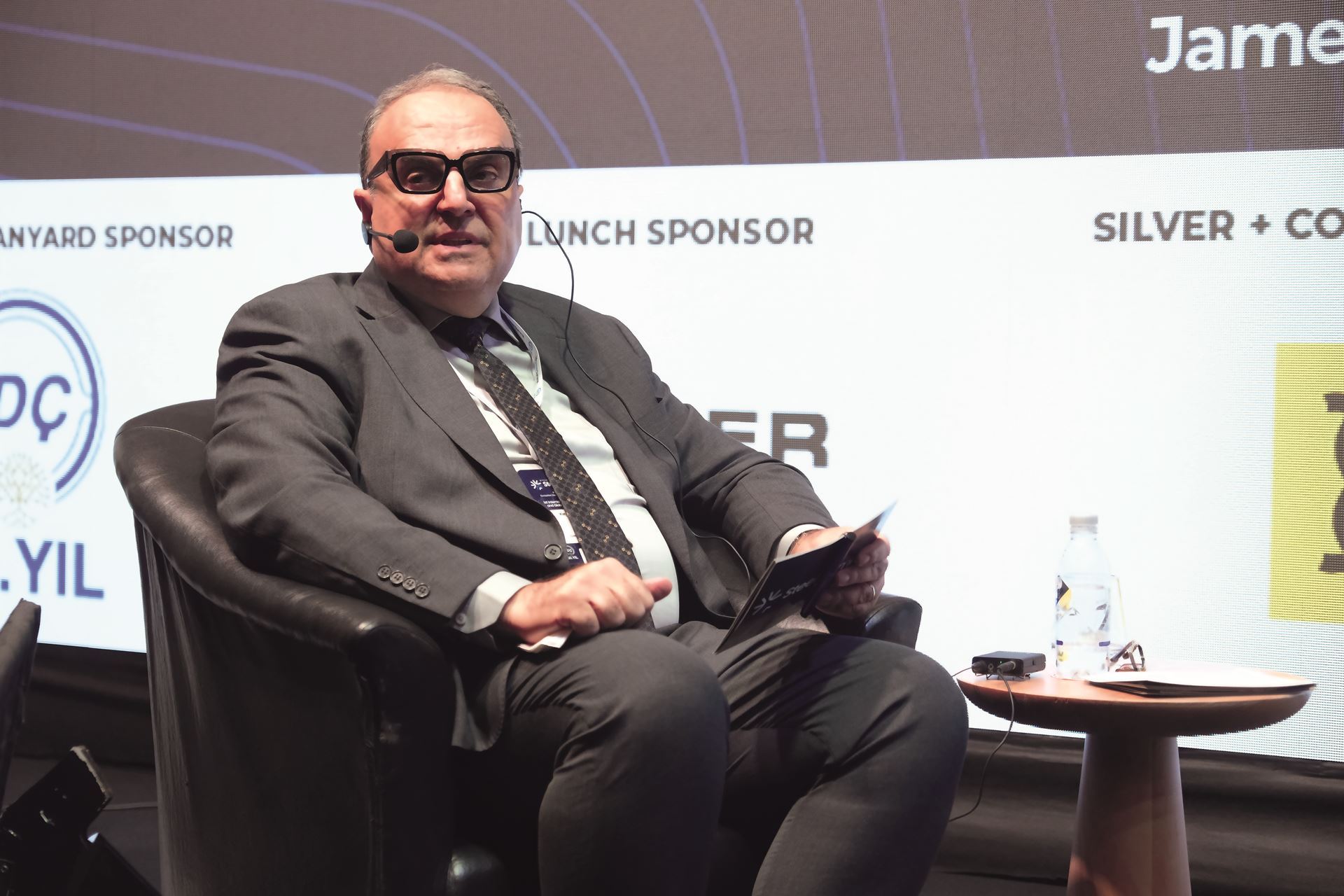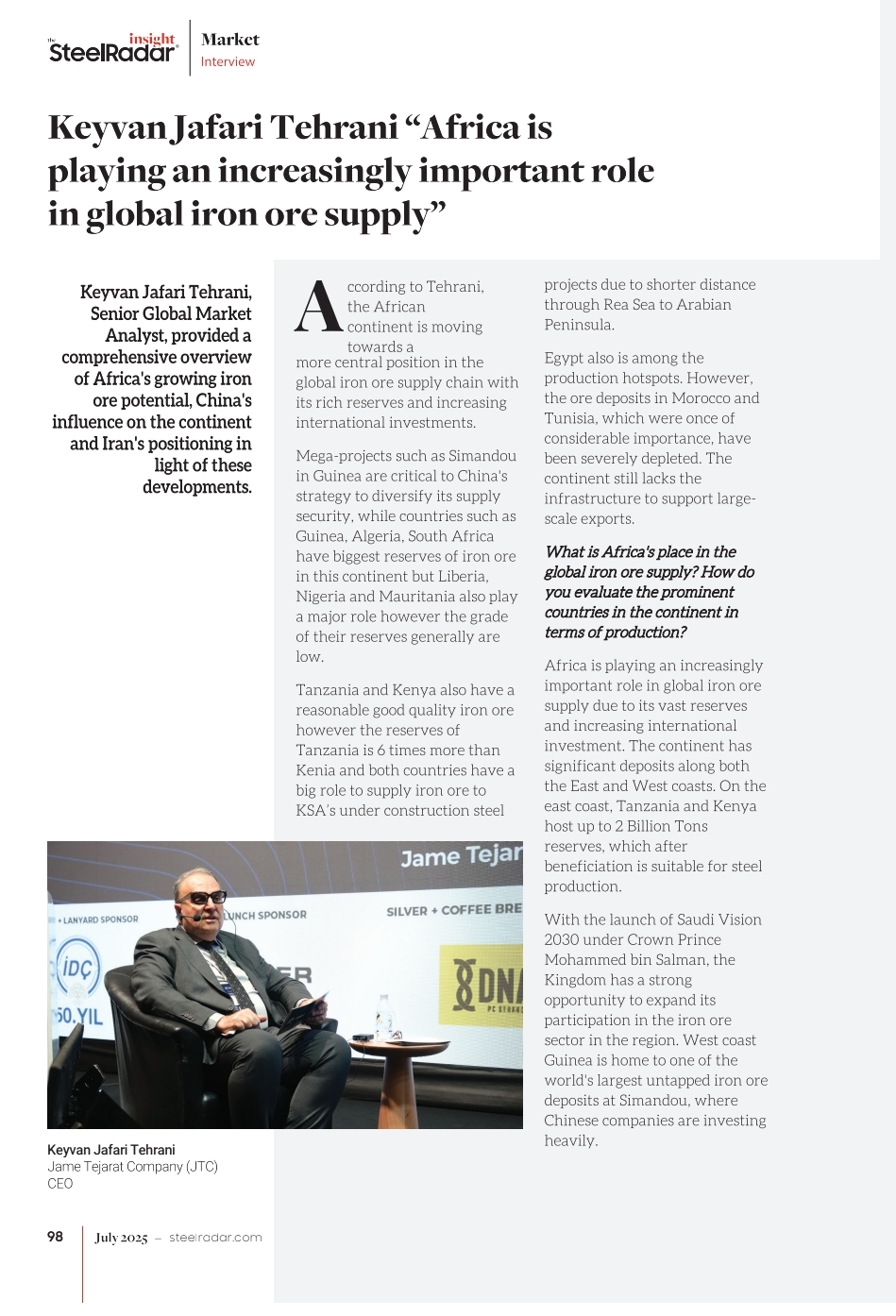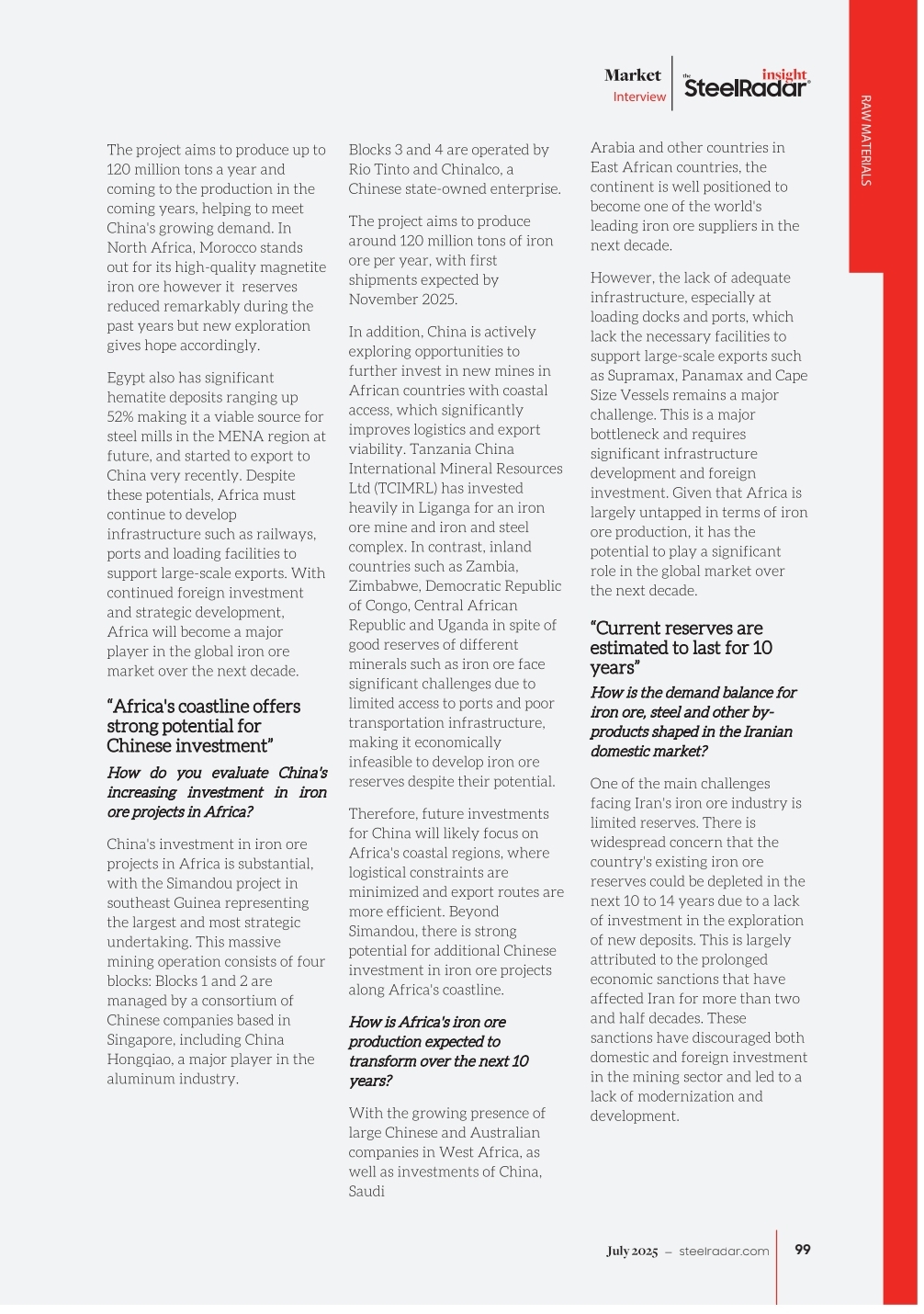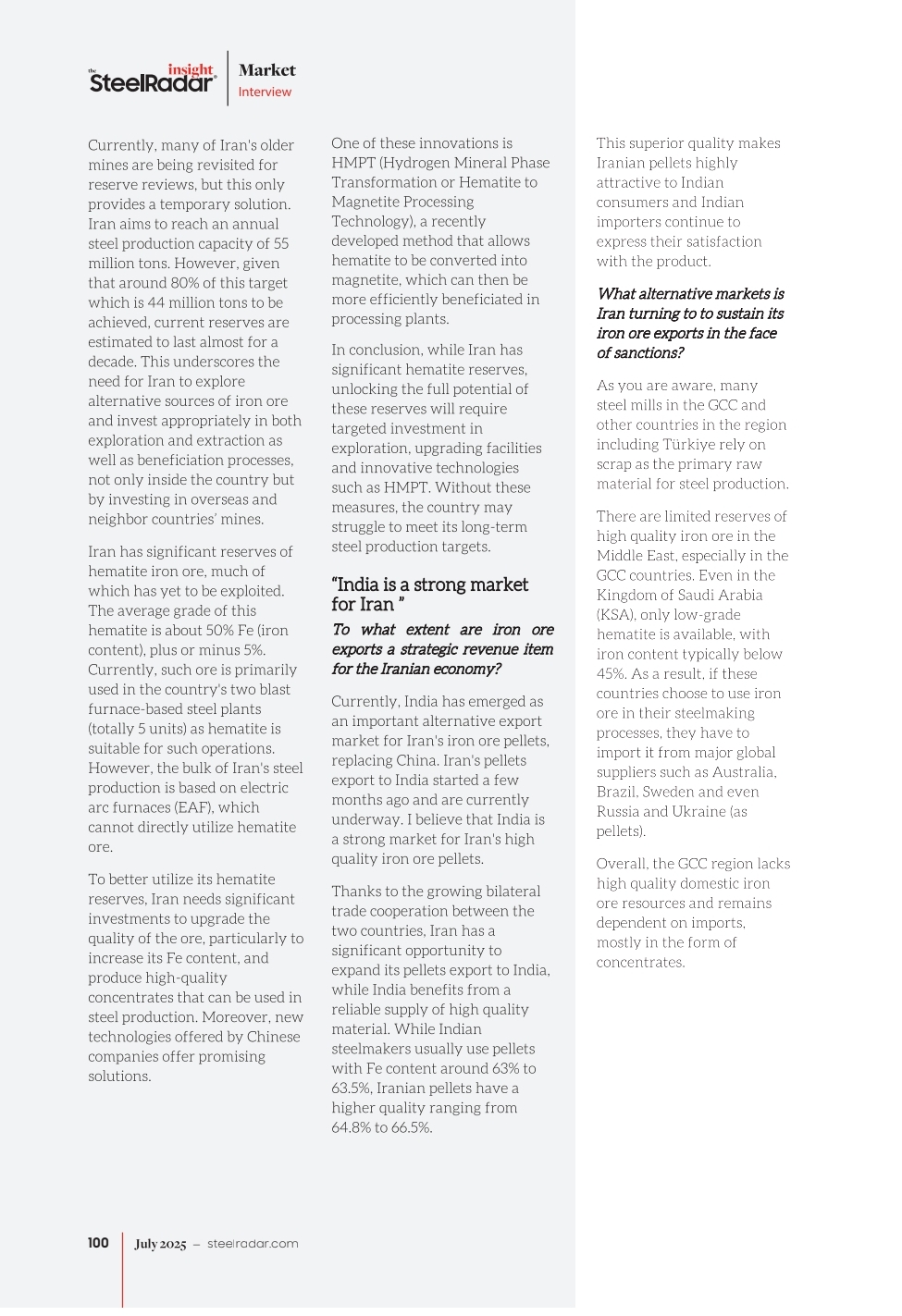
Keyvan Jafari Tehrani “Africa is playing an increasingly important role in global iron ore supply”
Keyvan Jafari Tehrani, Senior Global Market Analyst, provided a comprehensive overview of Africa’s growing iron ore potential, China’s influence on the continent and Iran’s positioning in light of these developments.
According to Tehrani, the African continent is moving towards a more central position in the global iron ore supply chain with its rich reserves and increasing international investments.
Mega-projects such as Simandou in Guinea are critical to China’s strategy to diversify its supply security, while countries such as Guinea, Algeria, South Africa have biggest reserves of iron ore in this continent but Liberia. Nigeria and Mauritania also play a major role however the grade of their reserves generally are low.
Tanzania and Kenya also have a reasonable good quality iron ore however the reserves of Tanzania is 6 times more than Kenia and both countries have a big role to supply iron ore to KSA’s under construction steel.
projects due to shorter distance through Rea Sea to Arabian Peninsula.
Egypt also is among the production hotspots. However, the ore deposits in Morocco and Tunisia, which were once of considerable importance, have been severely depleted. The continent still lacks the Infrastructure to support large scale exports.
1. Keyvan Jafari Tehrani “Africa is playing an increasingly important role in global iron ore supply”
Keyvan Jafari Tehrani, Senior Global Market Analyst, provided a comprehensive overview of Africa’s growing iron ore potential, China’s influence on the continent and Iran’s positioning in light of these developments. According to Tehrani, the African continent is moving towards a more central position in the global iron ore supply chain with its rich reserves and increasing international investments. Mega-projects such as Simandou in Guinea are critical to China’s strategy to diversify its supply security, while countries such as Guinea, Algeria, South Africa have biggest reserves of iron ore in this continent but Liberia, Nigeria and Mauritania also play a major role however the grade of their reserves generally are low. Tanzania and Kenya also have a reasonable good quality iron ore however the reserves of Tanzania is 6 times more than Kenia and both countries have a big role to supply iron ore to KSA’s under construction steel projects due to shorter distance through Rea Sea to Arabian Peninsula. Egypt also is among the production hotspots. However, the ore deposits in Morocco and Tunisia, which were once of considerable importance, have been severely depleted. The continent still lacks the infrastructure to support large-scale exports.
2. What is Africa’s place in the global iron ore supply?
How do you evaluate the prominent countries in the continent in terms of production?
Africa is playing an increasingly important role in global iron ore supply due to its vast reserves and increasing international investment. The continent has significant deposits along both the East and West coasts. On the east coast, Tanzania and Kenya host up to 2 Billion Tons reserves, which after beneficiation is suitable for steel production.
With the launch of Saudi Vision 2030 under Crown Prince Mohammed bin Salman, the Kingdom has a strong opportunity to expand its participation in the iron ore sector in the region. West coast Guinea is home to one of the world’s largest untapped iron ore deposits at Simandou, where Chinese companies are investing heavily. The project aims to produce up to 120 million tons a year and coming to the production in the coming years, helping to meet China’s growing demand. In North Africa, Morocco stands out for its high-quality magnetite iron ore however it reserves reduced remarkably during the past years but new exploration gives hope accordingly.
Egypt also has significant hematite deposits ranging up to 52%, making it a viable source for steel mills in the MENA region at future, and started to export to China very recently. Despite these potentials, Africa must continue to develop infrastructure such as railways, ports and loading facilities to support large-scale exports. With continued foreign investment and strategic development, Africa will become a major player in the global iron ore market over the next decade.
“Africa’s coastline offers strong potential for Chinese investment”
3. How do you evaluate China’s increasing investment in iron ore projects in Africa?
China’s investment in iron ore projects in Africa is substantial, with the Simandou project in southeastern` Guinea representing the largest and most strategic undertaking. This massive mining operation consists of four blocks: Blocks 1 and 2 are managed by a consortium of Chinese companies based in Singapore, including China Hongqiao, a major player in the aluminum industry. Blocks 3 and 4 are operated by Rio Tinto and Chinalco, a Chinese state-owned enterprise. The project aims to produce around 120 million tons of iron ore per year, with first shipments expected by November 2025.
In addition, China is actively exploring opportunities to further invest in new mines in African countries with coastal access, which significantly improves logistics and export viability. Tanzania China International Mineral Resources Ltd (TCIMRL) has invested heavily in Liganga for an iron ore mine and iron and steel complex. In contrast, inland countries such as Zambia, Zimbabwe, Democratic Republic of Congo, Central African Republic and Uganda in spite of good reserves of different minerals such as iron ore face significant challenges due to limited access to ports and poor transportation infrastructure, making it economically infeasible to develop iron ore reserves despite their potential. Therefore, future investments for China will likely focus on Africa’s coastal regions, where logistical constraints are minimized and export routes are more efficient. Beyond Simandou, there is strong potential for additional Chinese investment in iron ore projects along Africa’s coastline.
4. How is Africa’s iron ore production expected to transform over the next 10 years?
With the growing presence of large Chinese and Australian companies in West Africa, as well as investments of China, Saudi Arabia and other countries in East African countries, the continent is well positioned to become one of the world’s leading iron ore suppliers in the next decade. However, the lack of adequate infrastructure, especially at loading docks and ports, which lack the necessary facilities to support large-scale exports such as Supramax, Panamax and Cape Size Vessels remains a major challenge. This is a major bottleneck and requires significant infrastructure development and foreign investment. Given that Africa is largely untapped in terms of iron ore production, it has the potential to play a significant role in the global market over the next decade.
“Current reserves are estimated to last for 10 to 14 years”
5. How is the demand balance for iron ore, steel and other by-products shaped in the Iranian domestic market? One of the main challenges facing Iran’s iron ore industry is limited reserves. There is widespread concern that the country’s existing iron ore reserves could be depleted in the next 10 to 14 years due to a lack of investment in the exploration of new deposits. This is largely attributed to the prolonged economic sanctions that have affected Iran for more than two and half decades. These sanctions have discouraged both domestic and foreign investment in the mining sector and led to a lack of modernization and development.
Currently, many of Iran’s older mines are being revisited for reserve reviews, but this only provides a temporary solution. Iran aims to reach an annual steel production capacity of 55 million tons. However, given that around 80% of this target which is 44 million tons to be achieved, current reserves are estimated to last almost for a decade. This underscores the need for Iran to explore alternative sources of iron ore and invest appropriately in both exploration and extraction as well as beneficiation processes, not only inside the country but by investing in overseas and neighbor countries’ mines.
Iran has significant reserves of hematite iron ore, much of which has yet to be exploited. The average grade of this hematite is about 50% Fe (iron content), plus or minus 5%. Currently, such ore is primarily used in the country’s two blast furnace-based steel plants (totally 5 units) as hematite is suitable for such operations. However, the bulk of Iran’s steel production is based on electric arc furnaces (EAF), which cannot directly utilize hematite ore.
To better utilize its hematite reserves, Iran needs significant investments to upgrade the quality of the ore, particularly to increase its Fe content, and produce high-quality concentrates that can be used in steel production. Moreover, new technologies offered by Chinese companies offer promising solutions. One of these innovations is HMPT (Hydrogen Mineral Phase Transformation) or (Hematite to Magnetite Processing Technology), a recently developed method that allows hematite to be converted into magnetite, which can then be more efficiently beneficiated in processing plants.
In conclusion, while Iran has significant hematite reserves, unlocking the full potential of these reserves will require targeted investment in exploration, upgrading facilities and innovative technologies such as HMPT. Without these measures, the country may struggle to meet its long-term steel production targets.
6. India is a strong market for Iran
To what extent are iron ore pellets export a strategic revenue item for the Iranian economy?
Currently, India has emerged as an important alternative export market for Iran’s iron ore pellets, replacing China. Iran’s pellets export to India started a few months ago and are currently underway. I believe that India is a strong market for Iran’s high quality iron ore pellets.
Thanks to the growing bilateral trade cooperation between the two countries, Iran has a significant opportunity to expand its pellets export to India, while India benefits from a reliable supply of high quality material. While Indian steelmakers usually use pellets with Fe content around 63% to 63.5%, Iranian pellets have a higher quality ranging from 64.8% to 66.5%. This superior quality makes Iranian pellets highly attractive to Indian consumers and Indian importers continue to express their satisfaction with the product.
7. What alternative markets is Iran turning to sustain its iron ore exports in the face of sanctions?
As you are aware, many steel mills in the GCC and other countries in the region including Turkey rely on scrap as the primary raw material for steel production.
There are limited reserves of high quality iron ore in the Middle East, especially in the GCC countries. Even in the Kingdom of Saudi Arabia (KSA), only low-grade hematite is available, with iron content typically below 45%. As a result, if these countries choose to use iron ore in their steelmaking processes, they have to import it from major global suppliers such as Australia, Brazil, Sweden and even Russia and Ukraine (as pellets).
Overall, the GCC region lacks high quality domestic iron ore resources and remains dependent on imports, mostly in the form of concentrates.
Download the PDF file from here.



